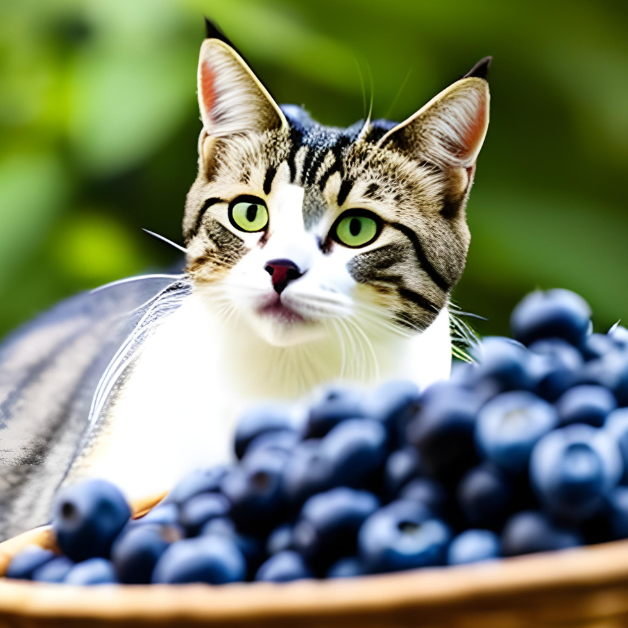Picture it – a sunny summer day, a gentle breeze blows as you pop fresh, juicy blueberries into your mouth. Their sweet tartness bursts with flavor. Looking up at you longingly is your curious cat, hoping for a taste. Can cats enjoy blueberries too? The answer is yes! When served safely, blueberries make a nutritious snack for cats.
This article explores the benefits and risks of cats eating blueberries. Learn about:
- Nutritional value of blueberries for cats
- Health benefits of blueberries
- Potential risks and downsides
- How to feed blueberries to cats
- Blueberry treat recipes for cats!
Let’s dive in and discuss why blueberries can be a purr-fect addition to your cat’s diet in moderation.
Table of Contents
Nutritional Value of Blueberries for Cats
Blueberries provide some key nutrients that are great for cats, including:
- Vitamin C – Supports immune health
- Fiber – Promotes digestion
- Antioxidants – Benefits cells and tissues
The water content in blueberries can also help with hydration.
So by sharing a few blueberries, you help provide important vitamins, minerals, and fiber. Just a couple berries go a long way nutritionally!
Health Benefits of Cats Eating Blueberries
Research shows blueberries offer various benefits:
- Urinary health – Prevent infections
- Healthy skin/coat – Vitamins C and E
- Eye health – Antioxidants protect vision
- Dental health – Fiber helps clean teeth
- Immune boost – Vitamin C supports immunity
The phytochemicals in blueberries act as antioxidants too. This protects cells from damage.
So by treating your cat to blueberries occasionally, you support their overall wellbeing!
Potential Risks and Downsides
While blueberries are safe for cats, some risks exist:
- Choking hazard – Whole berries may present choking risk. Cut them up!
- Allergies – Some cats may be allergic. Know your cat’s sensitivities!
- High sugar – Too many can cause upset stomach. Give just a few!
Cats tend to gulp their food, so breaking blueberries into bite-sized pieces helps prevent choking. And naturally high sugar content means portion control is key.
Overall though, blueberries offer more benefits than risks when fed properly.
Feeding Blueberries Safely to Cats
To safely share blueberries:
- Wash thoroughly – Rinse off any pesticides or chemicals
- Cut into pieces – Slice or crush to prevent choking
- Feed in moderation – Just 1-2 berries max per meal
- Watch for reactions – Ensure no signs of allergies
Start by introducing just a tiny piece. See if any GI upset or negative reaction occurs. Increase slowly to a few pieces at a time.
Only feed 1-2 times per week max as an occasional treat. Too much sugar from blueberries could cause diarrhea.
Have clean water available too for hydration. And as always, consult your vet about diet changes.
Fun Blueberry Treats and Recipes
Looking for ways to serve up blueberries to your cat? Try these easy recipes!
Blueberry Kitty Crumble
- 1/4 cup blueberries, crushed
- 1/4 cup crushed cat treats or kibble
- Mix together and serve!
Frozen Blueberry Yogurt Kitty Pops
- 1/4 cup plain yogurt
- 1 tsp blueberry puree
- Freeze in ice cube trays with popsicle sticks.
Blueberry Cat Birthday Cake
- Cat-safe cake batter or crushed treats
- Top with a few fresh blueberry pieces!
Get creative with mixing small amounts of blueberries into your cat’s normal foods. Cats love variety!
The Verdict: Blueberries AreFeline-Approved!
In conclusion, the occasional blueberry makes a healthy, safe treat for cats. Just be sure to introduce slowly and feed properly by:
- Cutting berries into bite-size pieces
- Moderating portions
- Monitoring for reactions
When shared safely, blueberries give cats a burst of nutrients, vitamins, and fiber. A few juicy berries can be a sweet surprise for your feline friend! Consult your vet if you have any concerns about incorporating blueberries.
Further Reading
PetMD – Can Cats Eat Blueberries?






